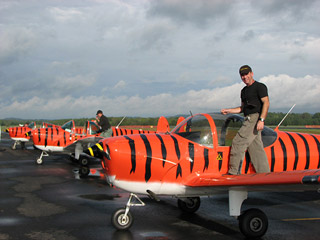
Phil Cataldo worried he had made a mistake. A fellow pilot, upon first seeing the bright orange and black striped tiger paint job on Cataldo’s airplane, remarked that it was a “terrible thing to do to a perfectly good airplane,” Cataldo recalled. That was in 2005, the new paint barely dry on his two-seat Alon A-2 Aircoupe, a descendent of the Ercoupe. Cataldo wondered if the tiger stripes were an expensive mistake.
Half an hour later, a pair of families showed up at the airport, their young children drawn to the “twin-tailed tiger” as if by magnetism. Cataldo made a point to point out this little gaggle of smiles to the skeptical fellow pilot.
“That’s what it’s all about,” Cataldo says about the eager response from the children. “He said, ‘You know what, you’re right.’”
At an airshow the following weekend, a pair of TigerFlight Alons parked on display between a pair of F-16s and a pair of F-15s trounced the fighters on the battlefield of child interest and attention.
“In 40 minutes they had to rope us off,” Cataldo recalled. “Couldn’t keep the kids off the airplanes.”
 TigerFlight pilots form up for airshows and events, and also teach children to be “pilot in command” of their own lives. Photo courtesy Phil Cataldo/TigerFlight Foundation.
TigerFlight pilots form up for airshows and events, and also teach children to be “pilot in command” of their own lives. Photo courtesy Phil Cataldo/TigerFlight Foundation.
Since then, Cataldo and a small group of friends and fellow pilots have worked to inspire children to take command of their lives and dream big. If those dreams happen to include aviation, so much the better— TigerFlight Foundation pilots offer free rides to the first 10 takers on the second Saturday of every month at Richard B. Russell airport. The group has also created ground programs for students who visit the vintage hangar where the foundation has found a home, in which a scale model of a WWII-era control tower and briefing room help set the stage for a message about being “pilot in command of your own life.”
Cataldo, who works in finance, said the goal of the program is to use aviation as the hook that catches attention, and to motivate children to create a flight plan for life in general. They equate dreams to the fuel that makes an airplane fly, for example, and prompt students (a target age range of 11 to 14) to begin thinking about their lives the way a pilot approaches a flight: with a mix of confidence, planning, and perseverance.
Cataldo said the group operates on a shoestring budget—pilots all supply their own aircraft and fuel for the introductory rides and formation appearances. Donations support ground-based programs, a combination of school visits and field trips to the airport, and Cataldo said the group hopes to recruit writers, artists, and more pilots to further develop the concept and create a seminar, cartoons, and books—the first of which has already been printed and distributed to area schools. Cataldo said that since 2005, about 2,000 children have participated in ground activities, and about 120 children got an airplane ride last year alone. With help and support from professional educators, the program has been aligned with state curriculum goals—particularly in science, technology, engineering, and math, the coveted STEM emphasis that remains a focus of teachers across the country. Cataldo hopes that with the right mix of sponsors and volunteers TigerFlight will grow into a national program. He will know he has succeeded, reached his “high-definition destination,” as he calls it, “when I’m driving down the road and I see a bumper sticker that says, ‘My child is a TigerFlight crewmember.’”
Meanwhile, Cataldo (a founding member) and his fellow TigerFlight pilots hope to boost their ranks and expand their reach at airshows, as a formation flying team with kid-catching static displays. Cataldo and his fellow pilots have already made themselves visible at various shows and events across the region, performing the Missing Man and honorary fly overs.
 Photo courtesy Phil Cataldo/TigerFlight Foundation.
Photo courtesy Phil Cataldo/TigerFlight Foundation.


